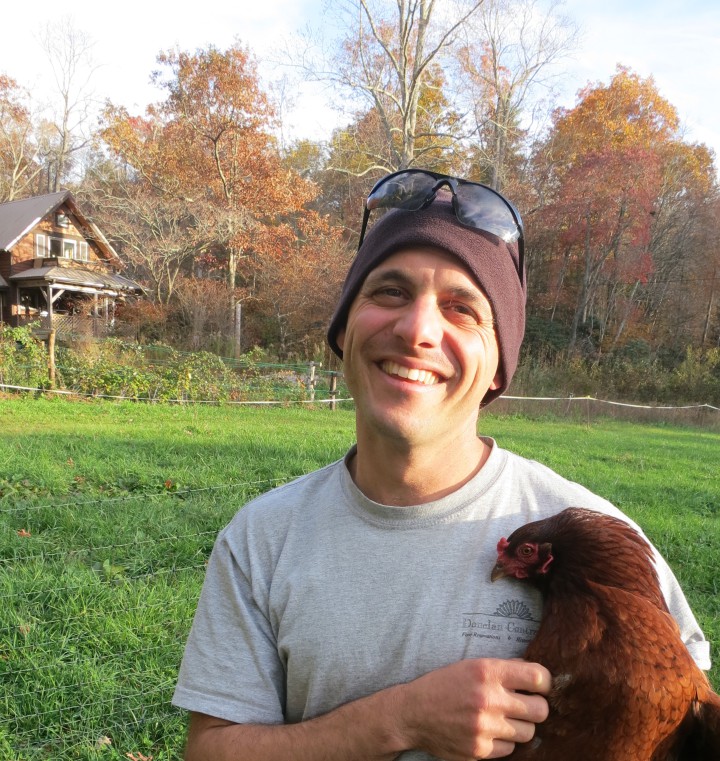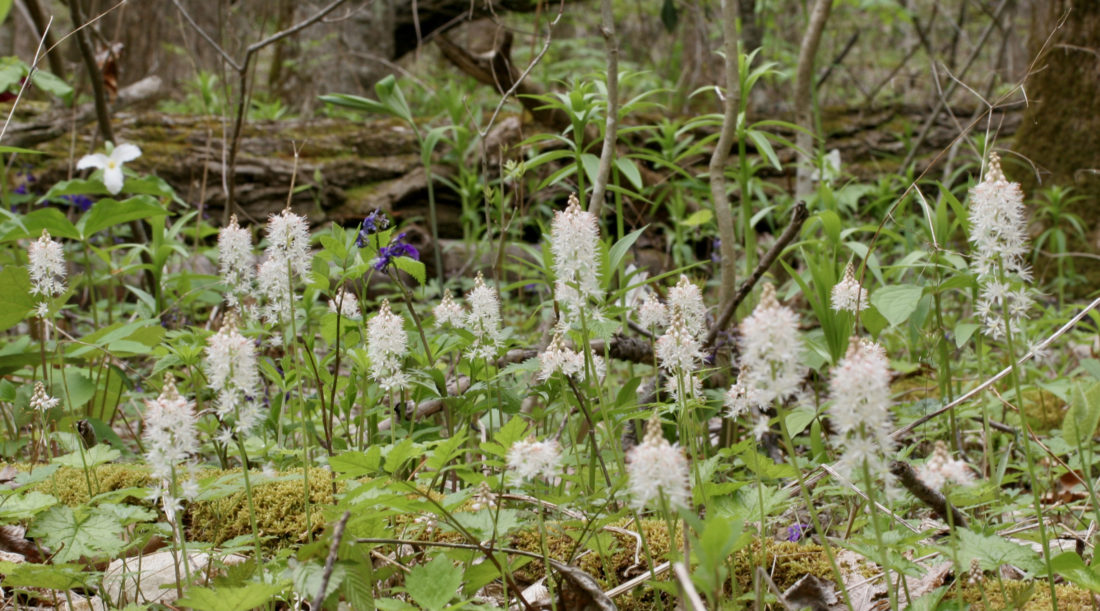BY TAL GALTON
A friend stopped by our house the other day. She was on her way to a forested cove in our community that we’ll call Ephemeral Holler. “Do you think the bloodroot is up?” she asked. She wanted to treat a wart on her finger.
It was mid-March, and at our elevation I was confident that the bloodroot was still tucked under the leaf litter, safe from her medicinal needs. “Dunno, seems a bit early,” I replied, “but it should be nice up there in any case.”
That set me thinking back to last April, during the peak of pandemic fear and uncertainty. While urban and suburban folks around the world were shut up in their dwellings, many in my mountain community took to the woods. And since it was spring, they were especially drawn to Ephemeral Holler. A normally obscure trail into the forest became more worn than ever before. This special place is locally renowned for its flush of early spring wildflowers, and people have been making annual pilgrimages there for generations. The lushest of local coves, it’s home to larkspur, bellwort, foamflower, Dutchman’s breeches and a veritable forest of trillium.

It’s long been known that species of trees, shrubs and forbs (herbaceous plants) grow in particular assemblages, partitioned into distinct botanical neighborhoods. Ecologists have identified hundreds of such native plant communities in North Carolina. From the spruce-fir cloud forests and grassy balds that crown our mountains to the coastal plain’s longleaf pine and maritime forests, botanists around the state have their respective favorites. Many mountain botanists have a soft spot for the community type that’s found in Ephemeral Holler: rich cove forests.
Western North Carolina boasts one of the great temperate forests of the world, and rich coves, found in swaths of various sizes, represent the Southern Appalachian forest at its finest. Some tree species found in rich coves are common throughout the Southern mountains: tulip poplar, sweet birch and red oak. Others, like basswood and shagbark hickory, are typically exclusive to rich coves. Still others, like the acid-loving sourwood, are entirely absent. The trees are what makes it a forest, but it’s the understory that sets these forest neighborhoods apart from acid coves and other Appalachian plant communities. The shrub layer in a rich cove is sparse — not a lot of rhododendrons and laurels — but the layer of herbaceous plants is as crowded and lush as in any landscape in the world.
Digging down
Appalachian rich coves are among the most diverse plant communities in North America, home to three times as many rare plant species as are found in other forest types. Botanists, ecologists and naturalists have long puzzled over why these particular coves are blanketed in such a diverse array of herbaceous plants while others are relatively barren. It was long thought that the difference was due mostly to moisture and aspect: Dry, south-facing slopes host fewer species than moist, sheltered bottomland forests.
But two decades ago, Chris Ulrey, now a plant ecologist with the National Park Service, published a study demonstrating that some of the variance can be chalked up to soil chemistry. Ulrey’s paper, oft-cited in the N.C. Natural Heritage Program’s definition of rich coves, attempted to unearth the origins of what it called a rich cove’s “aesthetic lavishness.” He concluded that soil fertility is a significant factor in determining the plant species found in each forest type. The abundant rich coves of the Craggy Mountains and Big Ivy, for instance, are due to the particular geology of this outcrop’s western slopes.
At the middle elevations, most rich cove wildflowers bloom in the weeks between mid-April and early May, when the strongest sunlight reaches the forest floor. Nearly all of these species have long-lived underground root systems (some as old as the trees above), but a few have above-ground parts so ephemeral that they’re evident for only six weeks each year. The ephemerals’ pace of leafing out, flowering and seed production is a race against the closing tree canopy and the growth of the larger full-season herbaceous plants: cohoshes, wood nettle and horse balm. By the end of May, the ephemerals are gone, and these “megaforbs” create a dense canopy 2-3 feet tall that lasts through the summer. Unlike many mountain forests, rich coves have a thick green carpet from April to September.
There’s a small rich cove that I regularly visit on one of my guided hikes. Every time we passed through last June and July, a pair of black-throated blue warblers flitted about in the underbrush. After the fall migration when the foliage had waned, I found the nest, right in the three-pronged crux of a blue cohosh. These euphonious, colorful neotropical migrants are like precious gems forged in the crucible of dense tropical rainforests, and when they migrate north, rich coves are a preferred habitat. Scarlet tanagers, black-throated blues and cerulean warblers all favor rich coves for their summer breeding grounds. These songbirds clearly know an affluent forest when they see one.
Paying it forward
For millennia, people have been drawn to rich coves in search of wild foods (ramps! morels!) and medicine (ginseng, cohosh and bloodroot). But these forests also fulfill another essential human need: a place to commune with nature in the deepest way possible.
The original spring fever was a hungry search for new growth. As gray winter rapidly greened, humans gathered succulent greenbriar, nettles, pungent ramps and tangy wild mustards. Over generations, we trained our minds to seek out diverse plant communities, and in the process, our brains gradually became wired to appreciate the beauty of a lush carpet of green foliage. This aspect of biophilia is what enables us to appreciate rich coves’ “aesthetic lavishness.”
Now, however, the powerfully medicinal goldenseal has been poached to near extinction, and ginseng, once abundant, is similarly rare. Even regionally adored ramps are at risk of overharvesting. So these days, we go to the forest to satiate our souls rather than our stomachs.
And while some rich coves have been able to recover from two centuries of logging and other disturbances, many of the richest forest soils were converted first to pasture or tillage, then to subdivisions. Even some that were allowed to return to forest haven’t fully recovered yet.
Together, we can help make these formerly rich ecosystems, many of them on unprotected private land, whole again.
Both places I’ve lived during my life in the mountains are near former rich coves. As my wife and I learned the native flora, it became evident which species wanted to live there, and in each place we removed the multiflora rose and encouraged the trillium and mayapples; we’ve planted foamflower, squirrel corn and ramps and watched them thrive. On a sunny April day I can watch and listen to the teeming rush hour of native bees and flies pollinating spring beauties and wood anemone. The wildflowers have reclaimed their former indigenous ground, and the forest floor sounds happy. Like the summer songbirds, we should honor and protect rich coves for what they are: a fabulous storehouse of biological knowledge and wisdom. It’s time to recompense these treasures for all they have given us: The forest itself is medicine for our troubled souls.
Burnsville resident Tal Galton runs Snakeroot Ecotours.




Great article, thank you. And yes, for sure… the decline of ginseng and ramp patches in the deep forest have been strikingly noticeable over the past forty years. The time to protect these valuable plants, and the rich cove forests that harbor them is now. The work of our regional land conservancies here WNC has been invaluable in this regard. Many thanks to them too.